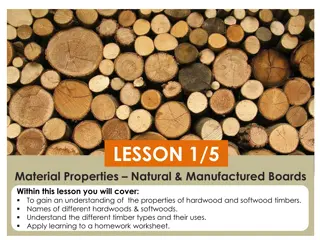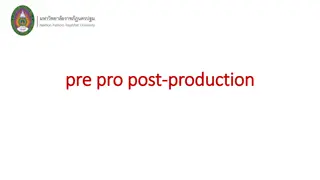Understanding Timber Production: Types, Classification, and Sustainability
Timber production involves the classification of timbers into hardwoods and softwoods based on the type of trees they come from. Hardwoods are from deciduous trees, while softwoods are from coniferous trees. Sustainable forestry practices, including managed logging activities, ensure the responsible harvesting of timber to safeguard forests for future generations. The conversion process involves sawing logs into marketable timber products.
Download Presentation

Please find below an Image/Link to download the presentation.
The content on the website is provided AS IS for your information and personal use only. It may not be sold, licensed, or shared on other websites without obtaining consent from the author. Download presentation by click this link. If you encounter any issues during the download, it is possible that the publisher has removed the file from their server.
E N D
Presentation Transcript
Natural Timber Production Page 1
Classification of Timbers Timbers can be classified under the headings: 1. Hardwoods 2. Softwoods This is an indication of the type of tree the wood comes from and is not a guide to the hardness or softness of the wood. Page 2
Classification of Timbers Hardwoods Deciduous trees (i.e. sheds its leafs seasonally) Softwoods Coniferous trees (i.e. evergreen - grow needles and cones as opposed to leaves) Type of Tree Slow growing and can take up to 100 years to mature Softwood grows at a faster rate and take approx. 30 years to mature depending on species. Generally cheaper as quick to grow and easy to replace Time to Mature Generally more expensive due to time to reach maturity Price Because of their condensed and more complex structure, (untreated) hardwoods generally offer a superior level of strength and durability. Oak, Teak, Sapele, Iroko, Beech, Maple and Walnut They are flexible, lighter in weight and less dense than most hardwoods. Properties Pine, Spruce, and Fir Examples Page 3
Sustainable Forestry Wood is a renewable resource; when forests are well managed (i.e. with consideration for the environment and the wildlife and the people who live and work in them), harvesting timber can actually be an effective way of safeguarding the forests for future generations. The Forest Stewardship Council (FSC) and the Programme for the Endorsement of Forest Certification (PEFC) are the largest global forest certification systems. They are separate, non-profit entities, but they share a common goal: to identify forests which are sustainably managed and environmentally sound. Products which carry the FSC or PEFC brands are made from materials which originate in well managed forests, or from trusted recycling sources. Page 4
Managed Forestry Cycle Logging activities can take many forms, from selective harvesting to limited, small-scale clear cutting, which, in temperate forests, can mimic natural disturbances such as fires or landslides. The goal is to harvest in such a way that allows these species the chance to regenerate, and ensures that the forest s overall ecological health is maintained, restored, or even enhanced. Page 5
Conversion Conversion is the term given to sawing the log into marketable timber. Tree Felled Transport to Sawmill Cut into Planks Page 6
Conversion Conversion Through and Through (Slab Sawn) Advantages Advantages Simplest, quickest and cheapest method Disadvantages Disadvantages Some planks are likely to warp, bow or twist Description Description Parallel cuts through the log Use Use Frequently used on softwoods as they are smaller in diameter Page 7
Conversion Conversion Quarter Sawn (Radial Sawn) Better quality and is less likely to warp, bow or twist. Promotes grain pattern. Time consuming process and involves much more man handling of the log. Wasteful process. More expensive. Quarter sawing tries to make the growth rings as short as possible to reduce warping. Hardwoods. Advantages Disadvantages Description Use Page 8
Seasoning Timber takes in moisture from a damp atmosphere but gives it up in a dry one. Disadvantages of unseasoned timber: Seasoning aims to remove excess, unwanted sap and moisture from timber Damp wood shrinks in dry air Dry wood swells in damp air Unseasoned green timber will twist, warp and crack Advantages of seasoning: Timber is more stable and is less likely to warp and crack and it makes it immune from rot and decay Page 9
Natural Air Seasoning A traditional form of drying hardwood used for centuries. Hardwood stacked within an open sided shed and natural air allowed to flow around them A sloping roof protects against direct sunlight and rain Advantages Advantages Disadvantages Disadvantages Traditional method Depends on weather conditions Cheap to operate Takes one year to season each 25mm of timber, plus a year Page 10
Artificial Kiln Seasoning Wood stacked on trolleys and wheeled into kiln Steam is introduced which soaks the timber Pressure and humidity reduced Advantages Advantages Steam drawn out by fans Quicker, more controlled reliable method. Quicker process 2 weeks per 25mm. Heat introduced and temperature raised Page 11























